Corporate Accounting Report: Financial Analysis of Surfstitch Ltd
VerifiedAdded on 2020/02/18
|12
|2945
|241
Report
AI Summary
This corporate accounting report provides a financial analysis of Surfstitch Ltd, evaluating its performance in 2015 and 2016. The report examines key financial metrics, including goodwill, investment in subsidiaries, cash positions, impairment costs, selling and distribution expenses, and administrative expenses. It assesses the company's financial predicament, highlighting the decline in operational capability and rising expenses that have impacted profitability. The analysis includes recommendations on whether to buy, hold, or sell Surfstitch Ltd shares, based on the company's financial viability and declining share value. Furthermore, the report delves into the importance and effectiveness of continuous reporting regimes for disclosure entities, discussing the role of Australian authorities in monitoring operations and mitigating unethical practices. The report references various articles and research papers to support its findings, emphasizing the significance of continuous disclosure in providing investors with accurate and timely information, thereby enabling them to make informed investment decisions and reduce investment risks. The report concludes that the continuous disclosure measure is viable and essential for organizations.
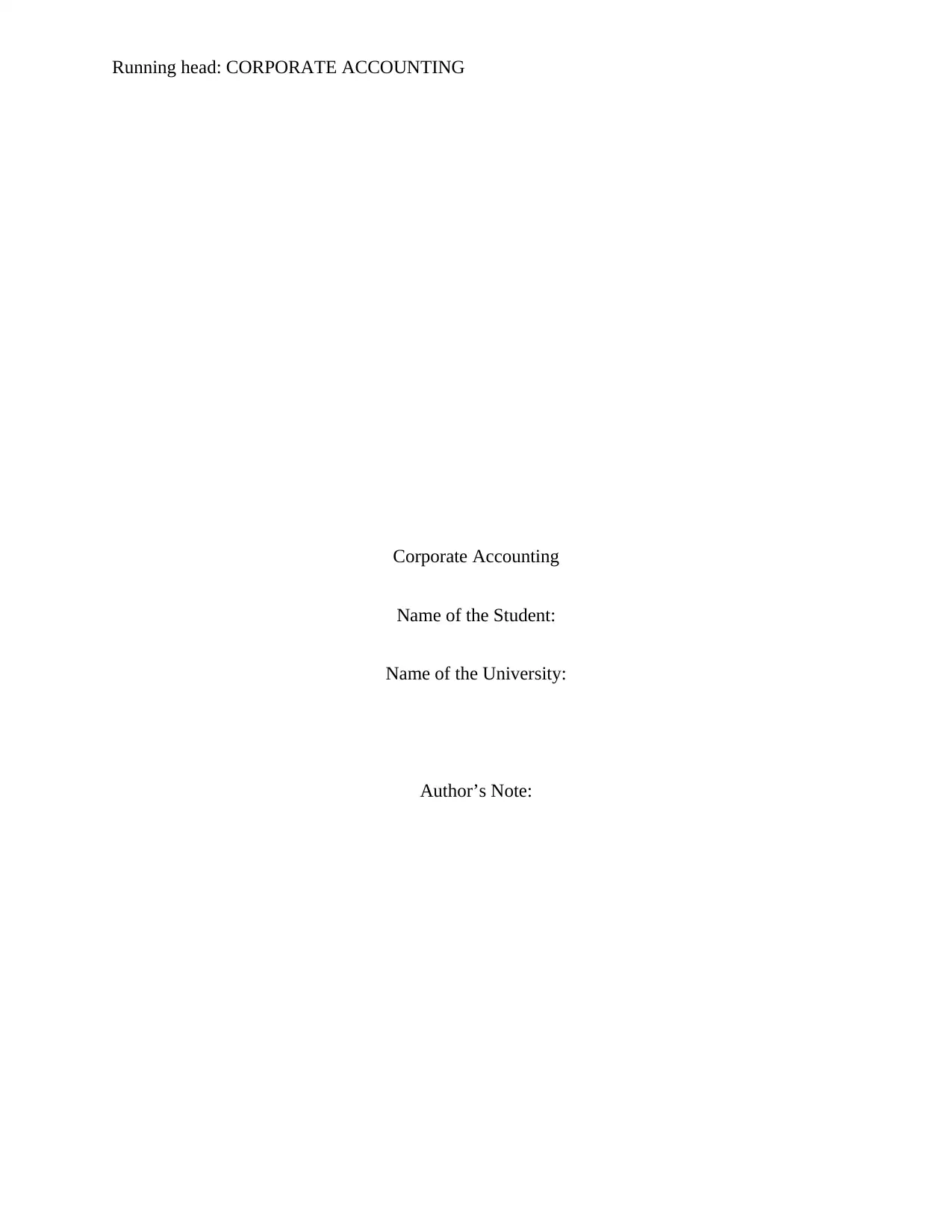
Running head: CORPORATE ACCOUNTING
Corporate Accounting
Name of the Student:
Name of the University:
Author’s Note:
Corporate Accounting
Name of the Student:
Name of the University:
Author’s Note:
Paraphrase This Document
Need a fresh take? Get an instant paraphrase of this document with our AI Paraphraser
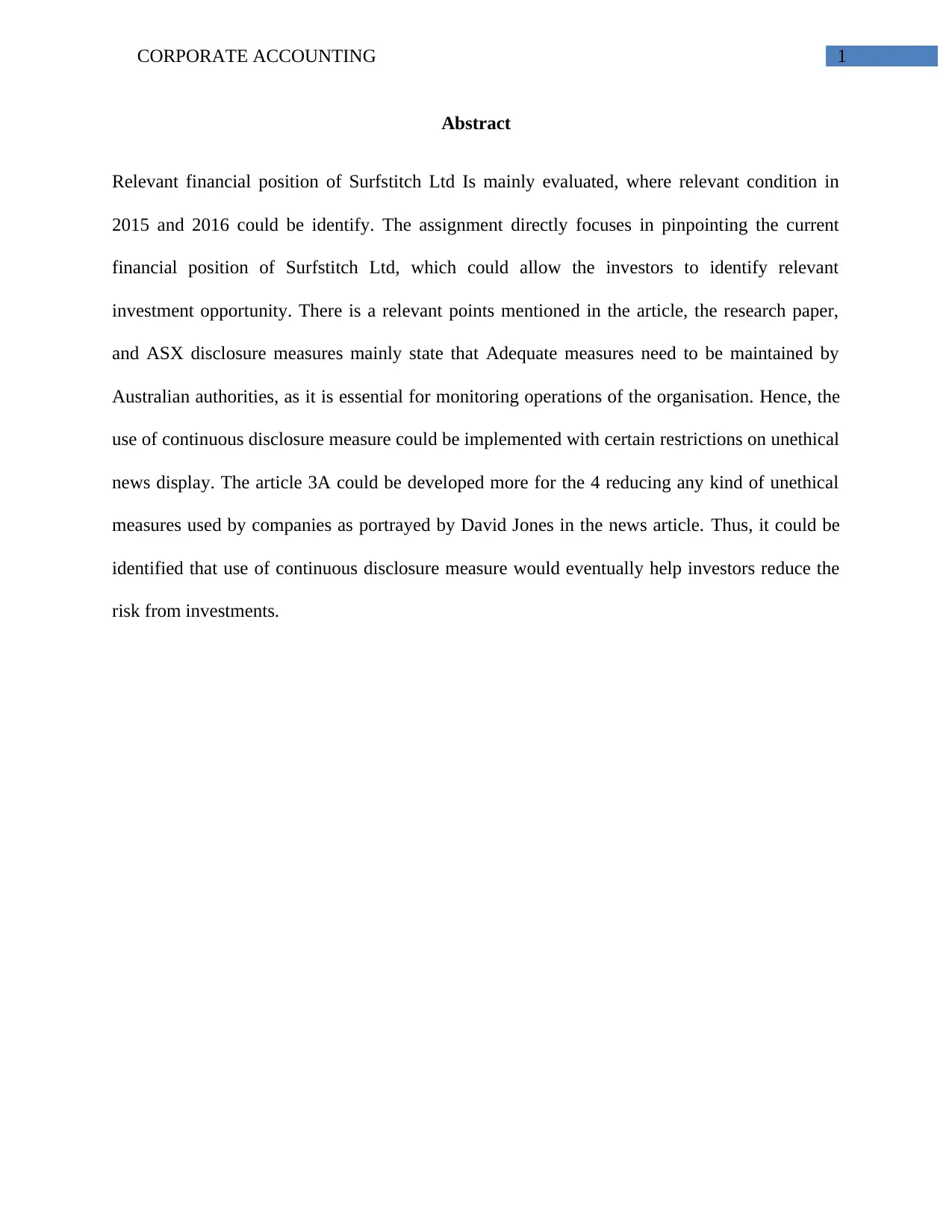
CORPORATE ACCOUNTING 1
Abstract
Relevant financial position of Surfstitch Ltd Is mainly evaluated, where relevant condition in
2015 and 2016 could be identify. The assignment directly focuses in pinpointing the current
financial position of Surfstitch Ltd, which could allow the investors to identify relevant
investment opportunity. There is a relevant points mentioned in the article, the research paper,
and ASX disclosure measures mainly state that Adequate measures need to be maintained by
Australian authorities, as it is essential for monitoring operations of the organisation. Hence, the
use of continuous disclosure measure could be implemented with certain restrictions on unethical
news display. The article 3A could be developed more for the 4 reducing any kind of unethical
measures used by companies as portrayed by David Jones in the news article. Thus, it could be
identified that use of continuous disclosure measure would eventually help investors reduce the
risk from investments.
Abstract
Relevant financial position of Surfstitch Ltd Is mainly evaluated, where relevant condition in
2015 and 2016 could be identify. The assignment directly focuses in pinpointing the current
financial position of Surfstitch Ltd, which could allow the investors to identify relevant
investment opportunity. There is a relevant points mentioned in the article, the research paper,
and ASX disclosure measures mainly state that Adequate measures need to be maintained by
Australian authorities, as it is essential for monitoring operations of the organisation. Hence, the
use of continuous disclosure measure could be implemented with certain restrictions on unethical
news display. The article 3A could be developed more for the 4 reducing any kind of unethical
measures used by companies as portrayed by David Jones in the news article. Thus, it could be
identified that use of continuous disclosure measure would eventually help investors reduce the
risk from investments.
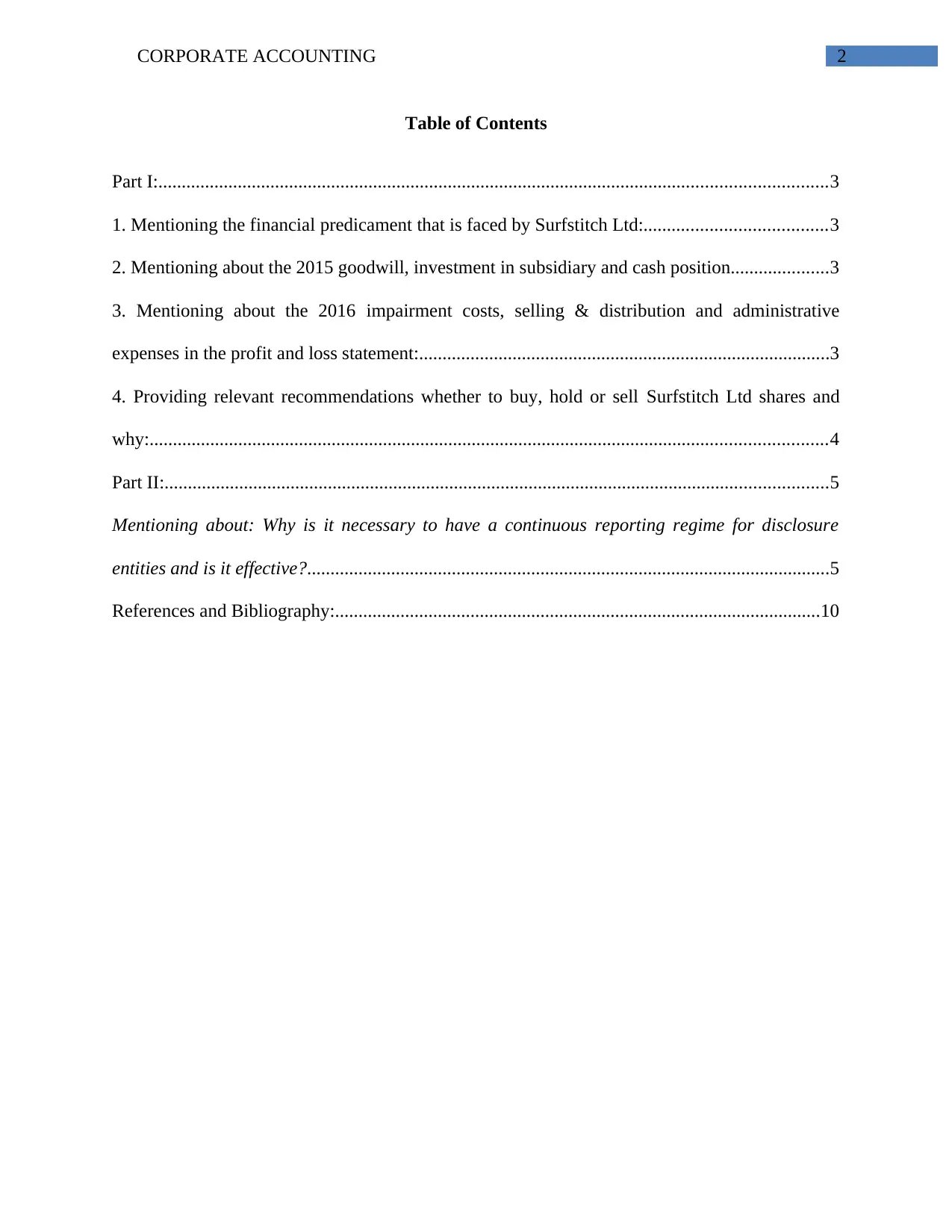
CORPORATE ACCOUNTING 2
Table of Contents
Part I:...............................................................................................................................................3
1. Mentioning the financial predicament that is faced by Surfstitch Ltd:.......................................3
2. Mentioning about the 2015 goodwill, investment in subsidiary and cash position.....................3
3. Mentioning about the 2016 impairment costs, selling & distribution and administrative
expenses in the profit and loss statement:........................................................................................3
4. Providing relevant recommendations whether to buy, hold or sell Surfstitch Ltd shares and
why:.................................................................................................................................................4
Part II:..............................................................................................................................................5
Mentioning about: Why is it necessary to have a continuous reporting regime for disclosure
entities and is it effective?................................................................................................................5
References and Bibliography:........................................................................................................10
Table of Contents
Part I:...............................................................................................................................................3
1. Mentioning the financial predicament that is faced by Surfstitch Ltd:.......................................3
2. Mentioning about the 2015 goodwill, investment in subsidiary and cash position.....................3
3. Mentioning about the 2016 impairment costs, selling & distribution and administrative
expenses in the profit and loss statement:........................................................................................3
4. Providing relevant recommendations whether to buy, hold or sell Surfstitch Ltd shares and
why:.................................................................................................................................................4
Part II:..............................................................................................................................................5
Mentioning about: Why is it necessary to have a continuous reporting regime for disclosure
entities and is it effective?................................................................................................................5
References and Bibliography:........................................................................................................10
⊘ This is a preview!⊘
Do you want full access?
Subscribe today to unlock all pages.

Trusted by 1+ million students worldwide
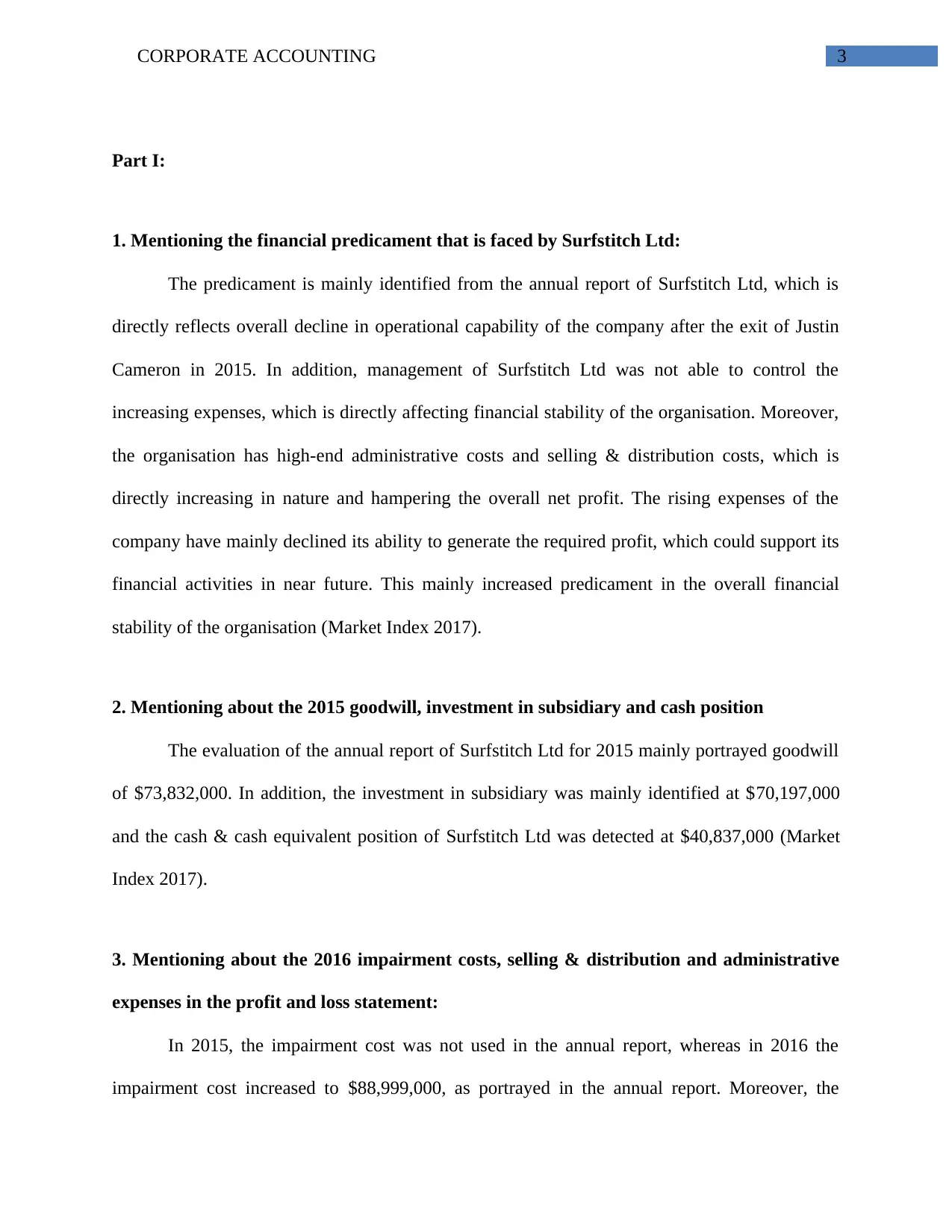
CORPORATE ACCOUNTING 3
Part I:
1. Mentioning the financial predicament that is faced by Surfstitch Ltd:
The predicament is mainly identified from the annual report of Surfstitch Ltd, which is
directly reflects overall decline in operational capability of the company after the exit of Justin
Cameron in 2015. In addition, management of Surfstitch Ltd was not able to control the
increasing expenses, which is directly affecting financial stability of the organisation. Moreover,
the organisation has high-end administrative costs and selling & distribution costs, which is
directly increasing in nature and hampering the overall net profit. The rising expenses of the
company have mainly declined its ability to generate the required profit, which could support its
financial activities in near future. This mainly increased predicament in the overall financial
stability of the organisation (Market Index 2017).
2. Mentioning about the 2015 goodwill, investment in subsidiary and cash position
The evaluation of the annual report of Surfstitch Ltd for 2015 mainly portrayed goodwill
of $73,832,000. In addition, the investment in subsidiary was mainly identified at $70,197,000
and the cash & cash equivalent position of Surfstitch Ltd was detected at $40,837,000 (Market
Index 2017).
3. Mentioning about the 2016 impairment costs, selling & distribution and administrative
expenses in the profit and loss statement:
In 2015, the impairment cost was not used in the annual report, whereas in 2016 the
impairment cost increased to $88,999,000, as portrayed in the annual report. Moreover, the
Part I:
1. Mentioning the financial predicament that is faced by Surfstitch Ltd:
The predicament is mainly identified from the annual report of Surfstitch Ltd, which is
directly reflects overall decline in operational capability of the company after the exit of Justin
Cameron in 2015. In addition, management of Surfstitch Ltd was not able to control the
increasing expenses, which is directly affecting financial stability of the organisation. Moreover,
the organisation has high-end administrative costs and selling & distribution costs, which is
directly increasing in nature and hampering the overall net profit. The rising expenses of the
company have mainly declined its ability to generate the required profit, which could support its
financial activities in near future. This mainly increased predicament in the overall financial
stability of the organisation (Market Index 2017).
2. Mentioning about the 2015 goodwill, investment in subsidiary and cash position
The evaluation of the annual report of Surfstitch Ltd for 2015 mainly portrayed goodwill
of $73,832,000. In addition, the investment in subsidiary was mainly identified at $70,197,000
and the cash & cash equivalent position of Surfstitch Ltd was detected at $40,837,000 (Market
Index 2017).
3. Mentioning about the 2016 impairment costs, selling & distribution and administrative
expenses in the profit and loss statement:
In 2015, the impairment cost was not used in the annual report, whereas in 2016 the
impairment cost increased to $88,999,000, as portrayed in the annual report. Moreover, the
Paraphrase This Document
Need a fresh take? Get an instant paraphrase of this document with our AI Paraphraser
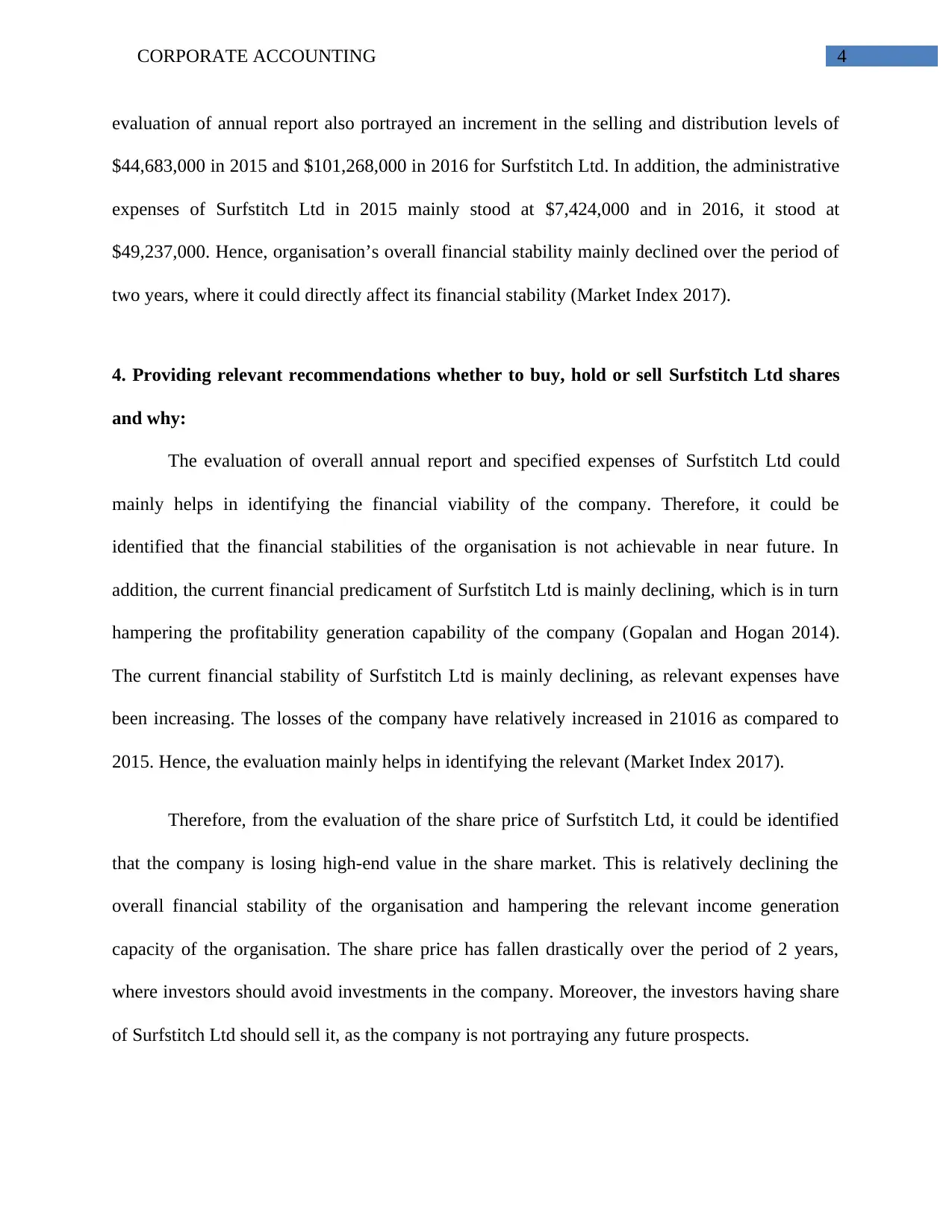
CORPORATE ACCOUNTING 4
evaluation of annual report also portrayed an increment in the selling and distribution levels of
$44,683,000 in 2015 and $101,268,000 in 2016 for Surfstitch Ltd. In addition, the administrative
expenses of Surfstitch Ltd in 2015 mainly stood at $7,424,000 and in 2016, it stood at
$49,237,000. Hence, organisation’s overall financial stability mainly declined over the period of
two years, where it could directly affect its financial stability (Market Index 2017).
4. Providing relevant recommendations whether to buy, hold or sell Surfstitch Ltd shares
and why:
The evaluation of overall annual report and specified expenses of Surfstitch Ltd could
mainly helps in identifying the financial viability of the company. Therefore, it could be
identified that the financial stabilities of the organisation is not achievable in near future. In
addition, the current financial predicament of Surfstitch Ltd is mainly declining, which is in turn
hampering the profitability generation capability of the company (Gopalan and Hogan 2014).
The current financial stability of Surfstitch Ltd is mainly declining, as relevant expenses have
been increasing. The losses of the company have relatively increased in 21016 as compared to
2015. Hence, the evaluation mainly helps in identifying the relevant (Market Index 2017).
Therefore, from the evaluation of the share price of Surfstitch Ltd, it could be identified
that the company is losing high-end value in the share market. This is relatively declining the
overall financial stability of the organisation and hampering the relevant income generation
capacity of the organisation. The share price has fallen drastically over the period of 2 years,
where investors should avoid investments in the company. Moreover, the investors having share
of Surfstitch Ltd should sell it, as the company is not portraying any future prospects.
evaluation of annual report also portrayed an increment in the selling and distribution levels of
$44,683,000 in 2015 and $101,268,000 in 2016 for Surfstitch Ltd. In addition, the administrative
expenses of Surfstitch Ltd in 2015 mainly stood at $7,424,000 and in 2016, it stood at
$49,237,000. Hence, organisation’s overall financial stability mainly declined over the period of
two years, where it could directly affect its financial stability (Market Index 2017).
4. Providing relevant recommendations whether to buy, hold or sell Surfstitch Ltd shares
and why:
The evaluation of overall annual report and specified expenses of Surfstitch Ltd could
mainly helps in identifying the financial viability of the company. Therefore, it could be
identified that the financial stabilities of the organisation is not achievable in near future. In
addition, the current financial predicament of Surfstitch Ltd is mainly declining, which is in turn
hampering the profitability generation capability of the company (Gopalan and Hogan 2014).
The current financial stability of Surfstitch Ltd is mainly declining, as relevant expenses have
been increasing. The losses of the company have relatively increased in 21016 as compared to
2015. Hence, the evaluation mainly helps in identifying the relevant (Market Index 2017).
Therefore, from the evaluation of the share price of Surfstitch Ltd, it could be identified
that the company is losing high-end value in the share market. This is relatively declining the
overall financial stability of the organisation and hampering the relevant income generation
capacity of the organisation. The share price has fallen drastically over the period of 2 years,
where investors should avoid investments in the company. Moreover, the investors having share
of Surfstitch Ltd should sell it, as the company is not portraying any future prospects.
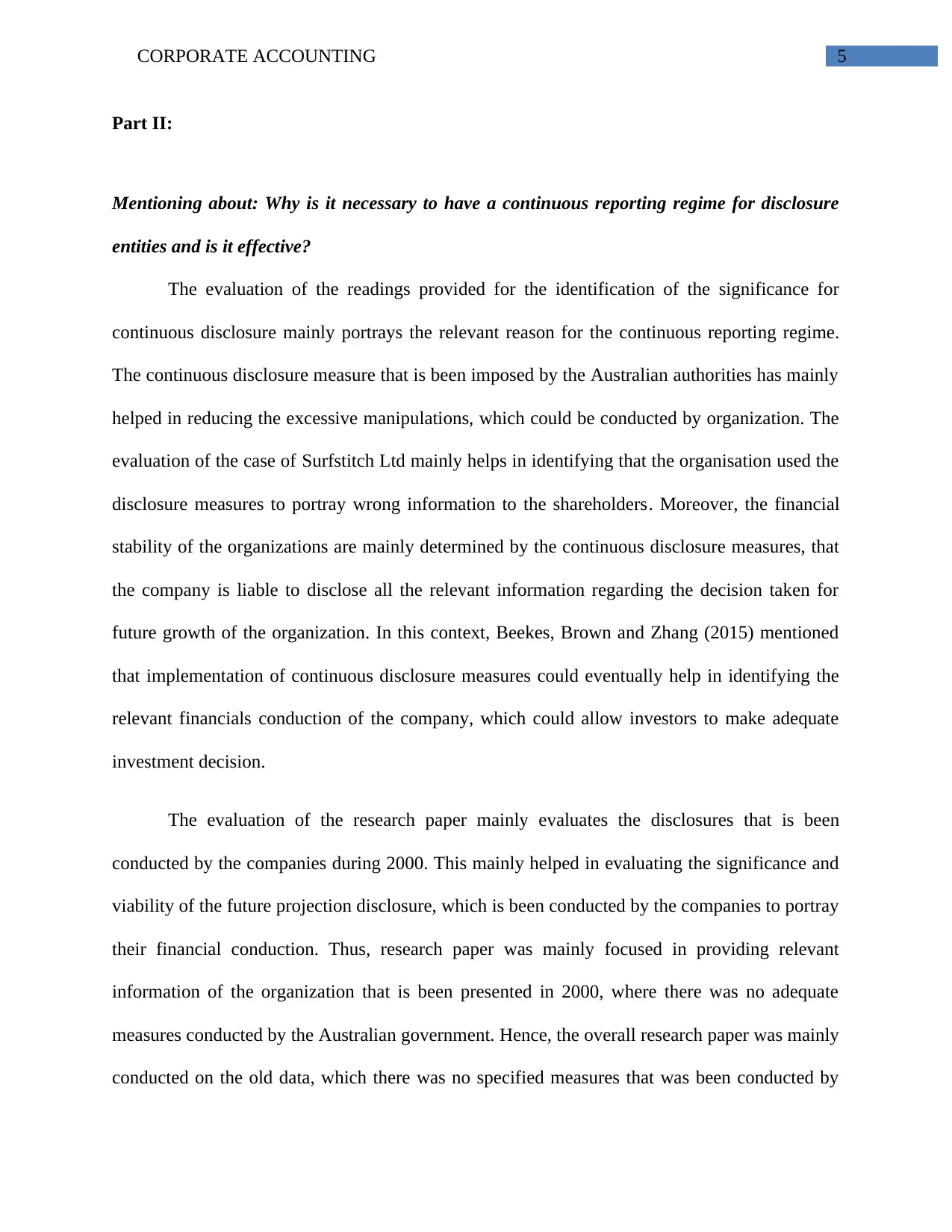
CORPORATE ACCOUNTING 5
Part II:
Mentioning about: Why is it necessary to have a continuous reporting regime for disclosure
entities and is it effective?
The evaluation of the readings provided for the identification of the significance for
continuous disclosure mainly portrays the relevant reason for the continuous reporting regime.
The continuous disclosure measure that is been imposed by the Australian authorities has mainly
helped in reducing the excessive manipulations, which could be conducted by organization. The
evaluation of the case of Surfstitch Ltd mainly helps in identifying that the organisation used the
disclosure measures to portray wrong information to the shareholders. Moreover, the financial
stability of the organizations are mainly determined by the continuous disclosure measures, that
the company is liable to disclose all the relevant information regarding the decision taken for
future growth of the organization. In this context, Beekes, Brown and Zhang (2015) mentioned
that implementation of continuous disclosure measures could eventually help in identifying the
relevant financials conduction of the company, which could allow investors to make adequate
investment decision.
The evaluation of the research paper mainly evaluates the disclosures that is been
conducted by the companies during 2000. This mainly helped in evaluating the significance and
viability of the future projection disclosure, which is been conducted by the companies to portray
their financial conduction. Thus, research paper was mainly focused in providing relevant
information of the organization that is been presented in 2000, where there was no adequate
measures conducted by the Australian government. Hence, the overall research paper was mainly
conducted on the old data, which there was no specified measures that was been conducted by
Part II:
Mentioning about: Why is it necessary to have a continuous reporting regime for disclosure
entities and is it effective?
The evaluation of the readings provided for the identification of the significance for
continuous disclosure mainly portrays the relevant reason for the continuous reporting regime.
The continuous disclosure measure that is been imposed by the Australian authorities has mainly
helped in reducing the excessive manipulations, which could be conducted by organization. The
evaluation of the case of Surfstitch Ltd mainly helps in identifying that the organisation used the
disclosure measures to portray wrong information to the shareholders. Moreover, the financial
stability of the organizations are mainly determined by the continuous disclosure measures, that
the company is liable to disclose all the relevant information regarding the decision taken for
future growth of the organization. In this context, Beekes, Brown and Zhang (2015) mentioned
that implementation of continuous disclosure measures could eventually help in identifying the
relevant financials conduction of the company, which could allow investors to make adequate
investment decision.
The evaluation of the research paper mainly evaluates the disclosures that is been
conducted by the companies during 2000. This mainly helped in evaluating the significance and
viability of the future projection disclosure, which is been conducted by the companies to portray
their financial conduction. Thus, research paper was mainly focused in providing relevant
information of the organization that is been presented in 2000, where there was no adequate
measures conducted by the Australian government. Hence, the overall research paper was mainly
conducted on the old data, which there was no specified measures that was been conducted by
⊘ This is a preview!⊘
Do you want full access?
Subscribe today to unlock all pages.

Trusted by 1+ million students worldwide
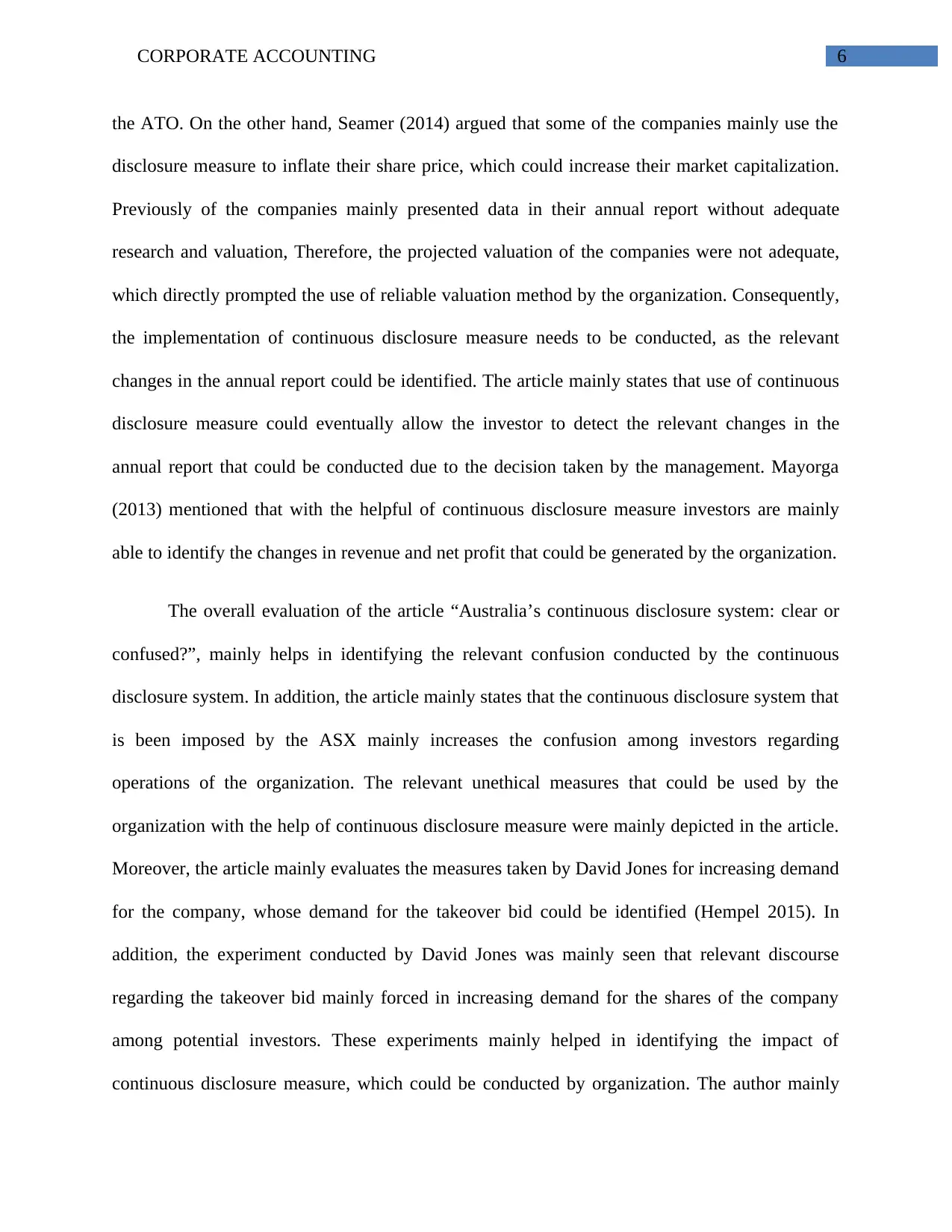
CORPORATE ACCOUNTING 6
the ATO. On the other hand, Seamer (2014) argued that some of the companies mainly use the
disclosure measure to inflate their share price, which could increase their market capitalization.
Previously of the companies mainly presented data in their annual report without adequate
research and valuation, Therefore, the projected valuation of the companies were not adequate,
which directly prompted the use of reliable valuation method by the organization. Consequently,
the implementation of continuous disclosure measure needs to be conducted, as the relevant
changes in the annual report could be identified. The article mainly states that use of continuous
disclosure measure could eventually allow the investor to detect the relevant changes in the
annual report that could be conducted due to the decision taken by the management. Mayorga
(2013) mentioned that with the helpful of continuous disclosure measure investors are mainly
able to identify the changes in revenue and net profit that could be generated by the organization.
The overall evaluation of the article “Australia’s continuous disclosure system: clear or
confused?”, mainly helps in identifying the relevant confusion conducted by the continuous
disclosure system. In addition, the article mainly states that the continuous disclosure system that
is been imposed by the ASX mainly increases the confusion among investors regarding
operations of the organization. The relevant unethical measures that could be used by the
organization with the help of continuous disclosure measure were mainly depicted in the article.
Moreover, the article mainly evaluates the measures taken by David Jones for increasing demand
for the company, whose demand for the takeover bid could be identified (Hempel 2015). In
addition, the experiment conducted by David Jones was mainly seen that relevant discourse
regarding the takeover bid mainly forced in increasing demand for the shares of the company
among potential investors. These experiments mainly helped in identifying the impact of
continuous disclosure measure, which could be conducted by organization. The author mainly
the ATO. On the other hand, Seamer (2014) argued that some of the companies mainly use the
disclosure measure to inflate their share price, which could increase their market capitalization.
Previously of the companies mainly presented data in their annual report without adequate
research and valuation, Therefore, the projected valuation of the companies were not adequate,
which directly prompted the use of reliable valuation method by the organization. Consequently,
the implementation of continuous disclosure measure needs to be conducted, as the relevant
changes in the annual report could be identified. The article mainly states that use of continuous
disclosure measure could eventually allow the investor to detect the relevant changes in the
annual report that could be conducted due to the decision taken by the management. Mayorga
(2013) mentioned that with the helpful of continuous disclosure measure investors are mainly
able to identify the changes in revenue and net profit that could be generated by the organization.
The overall evaluation of the article “Australia’s continuous disclosure system: clear or
confused?”, mainly helps in identifying the relevant confusion conducted by the continuous
disclosure system. In addition, the article mainly states that the continuous disclosure system that
is been imposed by the ASX mainly increases the confusion among investors regarding
operations of the organization. The relevant unethical measures that could be used by the
organization with the help of continuous disclosure measure were mainly depicted in the article.
Moreover, the article mainly evaluates the measures taken by David Jones for increasing demand
for the company, whose demand for the takeover bid could be identified (Hempel 2015). In
addition, the experiment conducted by David Jones was mainly seen that relevant discourse
regarding the takeover bid mainly forced in increasing demand for the shares of the company
among potential investors. These experiments mainly helped in identifying the impact of
continuous disclosure measure, which could be conducted by organization. The author mainly
Paraphrase This Document
Need a fresh take? Get an instant paraphrase of this document with our AI Paraphraser
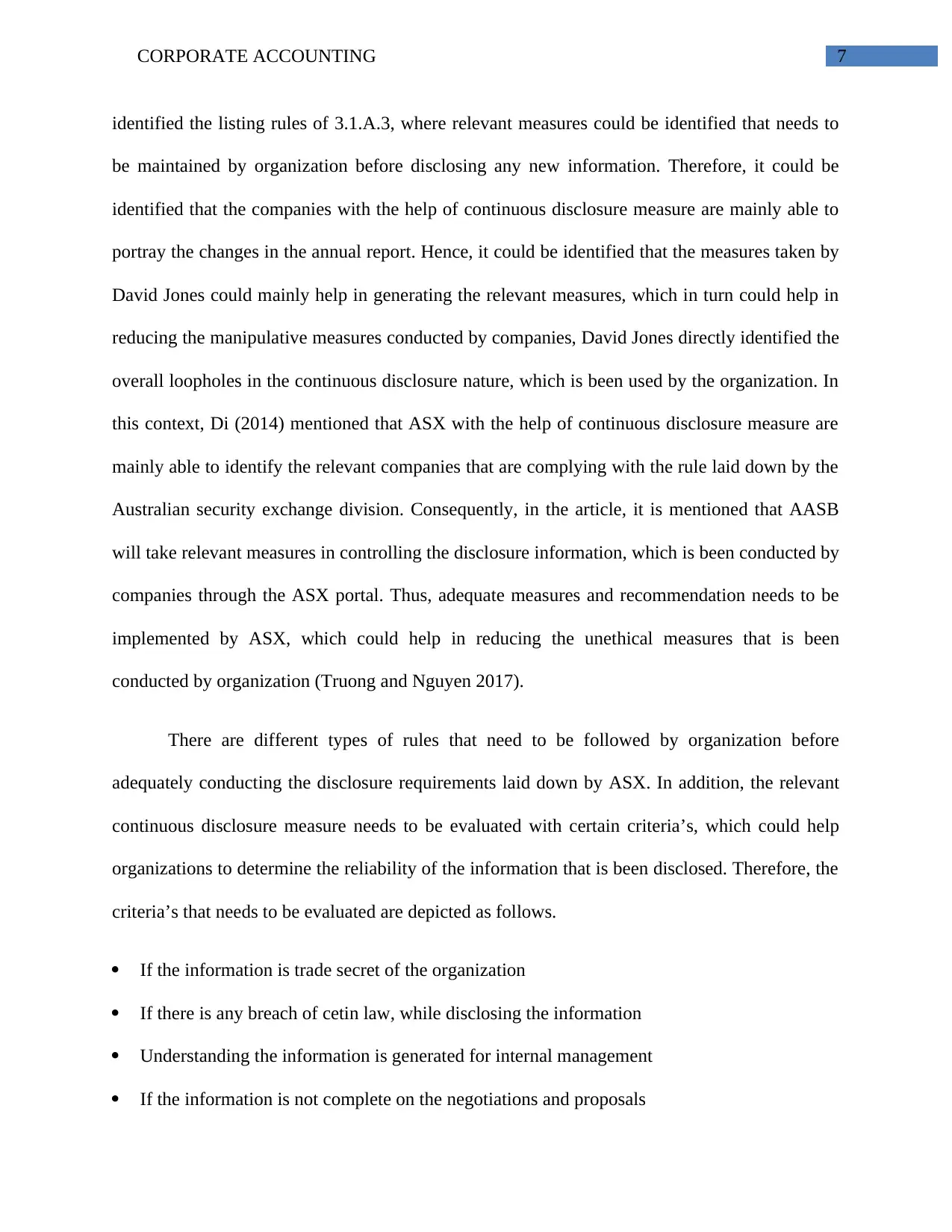
CORPORATE ACCOUNTING 7
identified the listing rules of 3.1.A.3, where relevant measures could be identified that needs to
be maintained by organization before disclosing any new information. Therefore, it could be
identified that the companies with the help of continuous disclosure measure are mainly able to
portray the changes in the annual report. Hence, it could be identified that the measures taken by
David Jones could mainly help in generating the relevant measures, which in turn could help in
reducing the manipulative measures conducted by companies, David Jones directly identified the
overall loopholes in the continuous disclosure nature, which is been used by the organization. In
this context, Di (2014) mentioned that ASX with the help of continuous disclosure measure are
mainly able to identify the relevant companies that are complying with the rule laid down by the
Australian security exchange division. Consequently, in the article, it is mentioned that AASB
will take relevant measures in controlling the disclosure information, which is been conducted by
companies through the ASX portal. Thus, adequate measures and recommendation needs to be
implemented by ASX, which could help in reducing the unethical measures that is been
conducted by organization (Truong and Nguyen 2017).
There are different types of rules that need to be followed by organization before
adequately conducting the disclosure requirements laid down by ASX. In addition, the relevant
continuous disclosure measure needs to be evaluated with certain criteria’s, which could help
organizations to determine the reliability of the information that is been disclosed. Therefore, the
criteria’s that needs to be evaluated are depicted as follows.
If the information is trade secret of the organization
If there is any breach of cetin law, while disclosing the information
Understanding the information is generated for internal management
If the information is not complete on the negotiations and proposals
identified the listing rules of 3.1.A.3, where relevant measures could be identified that needs to
be maintained by organization before disclosing any new information. Therefore, it could be
identified that the companies with the help of continuous disclosure measure are mainly able to
portray the changes in the annual report. Hence, it could be identified that the measures taken by
David Jones could mainly help in generating the relevant measures, which in turn could help in
reducing the manipulative measures conducted by companies, David Jones directly identified the
overall loopholes in the continuous disclosure nature, which is been used by the organization. In
this context, Di (2014) mentioned that ASX with the help of continuous disclosure measure are
mainly able to identify the relevant companies that are complying with the rule laid down by the
Australian security exchange division. Consequently, in the article, it is mentioned that AASB
will take relevant measures in controlling the disclosure information, which is been conducted by
companies through the ASX portal. Thus, adequate measures and recommendation needs to be
implemented by ASX, which could help in reducing the unethical measures that is been
conducted by organization (Truong and Nguyen 2017).
There are different types of rules that need to be followed by organization before
adequately conducting the disclosure requirements laid down by ASX. In addition, the relevant
continuous disclosure measure needs to be evaluated with certain criteria’s, which could help
organizations to determine the reliability of the information that is been disclosed. Therefore, the
criteria’s that needs to be evaluated are depicted as follows.
If the information is trade secret of the organization
If there is any breach of cetin law, while disclosing the information
Understanding the information is generated for internal management
If the information is not complete on the negotiations and proposals
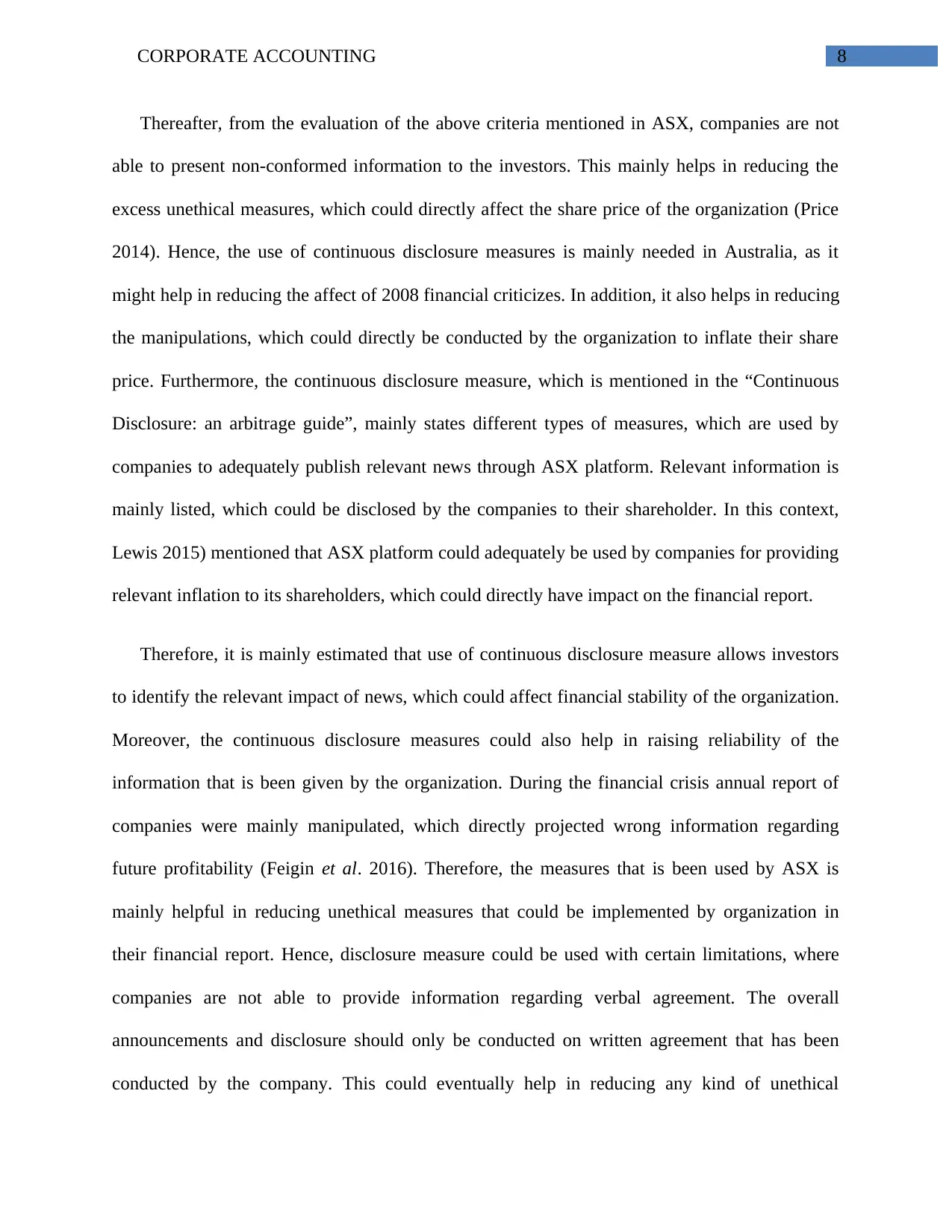
CORPORATE ACCOUNTING 8
Thereafter, from the evaluation of the above criteria mentioned in ASX, companies are not
able to present non-conformed information to the investors. This mainly helps in reducing the
excess unethical measures, which could directly affect the share price of the organization (Price
2014). Hence, the use of continuous disclosure measures is mainly needed in Australia, as it
might help in reducing the affect of 2008 financial criticizes. In addition, it also helps in reducing
the manipulations, which could directly be conducted by the organization to inflate their share
price. Furthermore, the continuous disclosure measure, which is mentioned in the “Continuous
Disclosure: an arbitrage guide”, mainly states different types of measures, which are used by
companies to adequately publish relevant news through ASX platform. Relevant information is
mainly listed, which could be disclosed by the companies to their shareholder. In this context,
Lewis 2015) mentioned that ASX platform could adequately be used by companies for providing
relevant inflation to its shareholders, which could directly have impact on the financial report.
Therefore, it is mainly estimated that use of continuous disclosure measure allows investors
to identify the relevant impact of news, which could affect financial stability of the organization.
Moreover, the continuous disclosure measures could also help in raising reliability of the
information that is been given by the organization. During the financial crisis annual report of
companies were mainly manipulated, which directly projected wrong information regarding
future profitability (Feigin et al. 2016). Therefore, the measures that is been used by ASX is
mainly helpful in reducing unethical measures that could be implemented by organization in
their financial report. Hence, disclosure measure could be used with certain limitations, where
companies are not able to provide information regarding verbal agreement. The overall
announcements and disclosure should only be conducted on written agreement that has been
conducted by the company. This could eventually help in reducing any kind of unethical
Thereafter, from the evaluation of the above criteria mentioned in ASX, companies are not
able to present non-conformed information to the investors. This mainly helps in reducing the
excess unethical measures, which could directly affect the share price of the organization (Price
2014). Hence, the use of continuous disclosure measures is mainly needed in Australia, as it
might help in reducing the affect of 2008 financial criticizes. In addition, it also helps in reducing
the manipulations, which could directly be conducted by the organization to inflate their share
price. Furthermore, the continuous disclosure measure, which is mentioned in the “Continuous
Disclosure: an arbitrage guide”, mainly states different types of measures, which are used by
companies to adequately publish relevant news through ASX platform. Relevant information is
mainly listed, which could be disclosed by the companies to their shareholder. In this context,
Lewis 2015) mentioned that ASX platform could adequately be used by companies for providing
relevant inflation to its shareholders, which could directly have impact on the financial report.
Therefore, it is mainly estimated that use of continuous disclosure measure allows investors
to identify the relevant impact of news, which could affect financial stability of the organization.
Moreover, the continuous disclosure measures could also help in raising reliability of the
information that is been given by the organization. During the financial crisis annual report of
companies were mainly manipulated, which directly projected wrong information regarding
future profitability (Feigin et al. 2016). Therefore, the measures that is been used by ASX is
mainly helpful in reducing unethical measures that could be implemented by organization in
their financial report. Hence, disclosure measure could be used with certain limitations, where
companies are not able to provide information regarding verbal agreement. The overall
announcements and disclosure should only be conducted on written agreement that has been
conducted by the company. This could eventually help in reducing any kind of unethical
⊘ This is a preview!⊘
Do you want full access?
Subscribe today to unlock all pages.

Trusted by 1+ million students worldwide
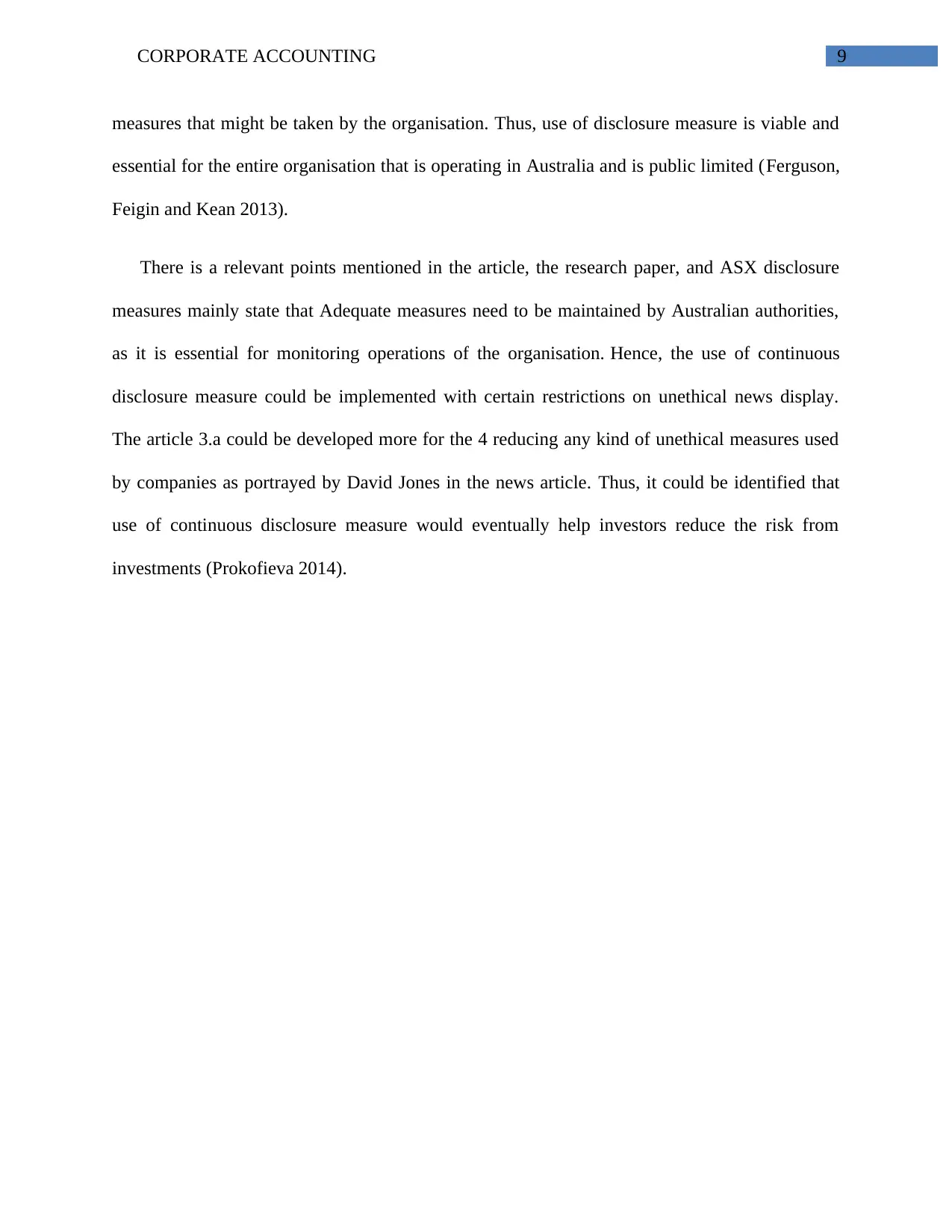
CORPORATE ACCOUNTING 9
measures that might be taken by the organisation. Thus, use of disclosure measure is viable and
essential for the entire organisation that is operating in Australia and is public limited (Ferguson,
Feigin and Kean 2013).
There is a relevant points mentioned in the article, the research paper, and ASX disclosure
measures mainly state that Adequate measures need to be maintained by Australian authorities,
as it is essential for monitoring operations of the organisation. Hence, the use of continuous
disclosure measure could be implemented with certain restrictions on unethical news display.
The article 3.a could be developed more for the 4 reducing any kind of unethical measures used
by companies as portrayed by David Jones in the news article. Thus, it could be identified that
use of continuous disclosure measure would eventually help investors reduce the risk from
investments (Prokofieva 2014).
measures that might be taken by the organisation. Thus, use of disclosure measure is viable and
essential for the entire organisation that is operating in Australia and is public limited (Ferguson,
Feigin and Kean 2013).
There is a relevant points mentioned in the article, the research paper, and ASX disclosure
measures mainly state that Adequate measures need to be maintained by Australian authorities,
as it is essential for monitoring operations of the organisation. Hence, the use of continuous
disclosure measure could be implemented with certain restrictions on unethical news display.
The article 3.a could be developed more for the 4 reducing any kind of unethical measures used
by companies as portrayed by David Jones in the news article. Thus, it could be identified that
use of continuous disclosure measure would eventually help investors reduce the risk from
investments (Prokofieva 2014).
Paraphrase This Document
Need a fresh take? Get an instant paraphrase of this document with our AI Paraphraser
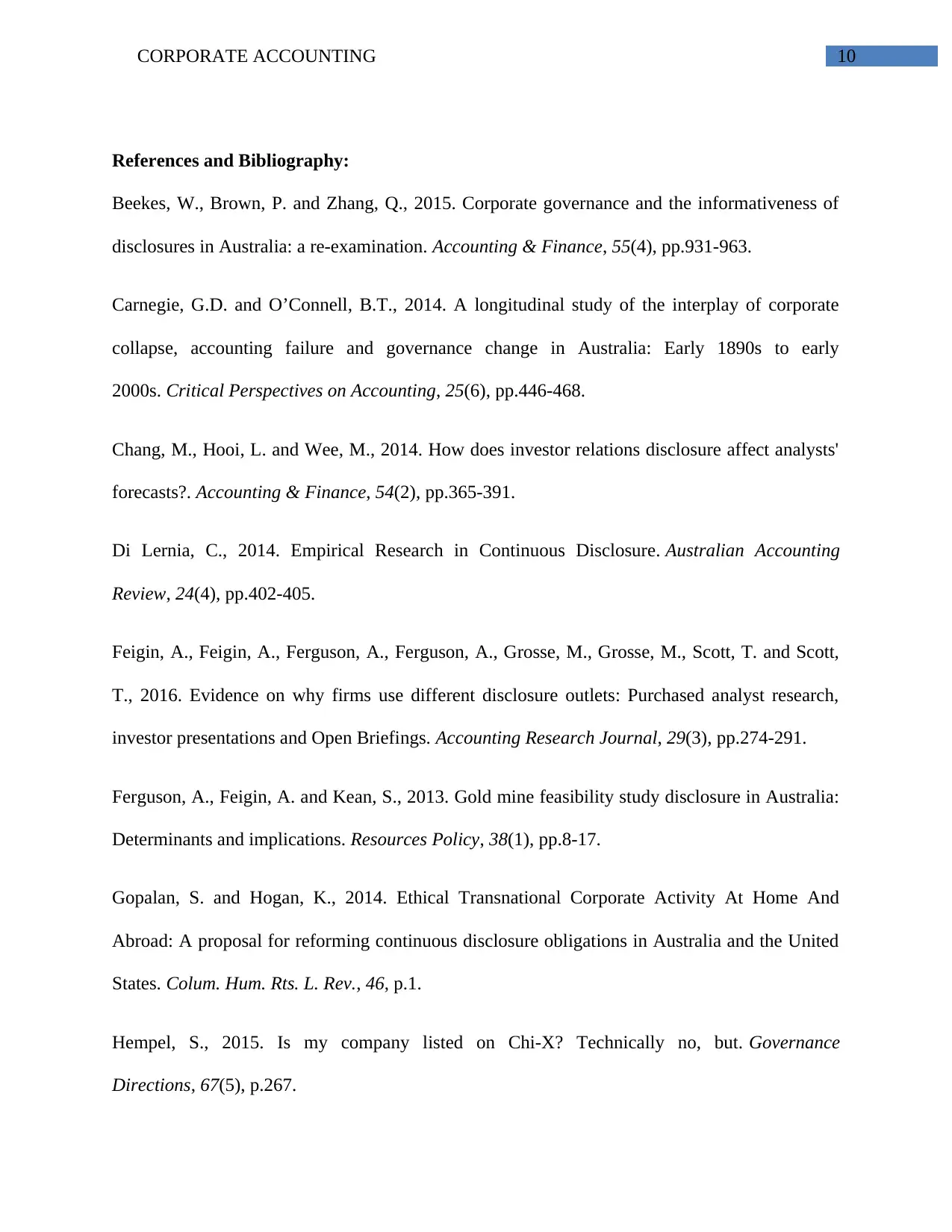
CORPORATE ACCOUNTING 10
References and Bibliography:
Beekes, W., Brown, P. and Zhang, Q., 2015. Corporate governance and the informativeness of
disclosures in Australia: a re‐examination. Accounting & Finance, 55(4), pp.931-963.
Carnegie, G.D. and O’Connell, B.T., 2014. A longitudinal study of the interplay of corporate
collapse, accounting failure and governance change in Australia: Early 1890s to early
2000s. Critical Perspectives on Accounting, 25(6), pp.446-468.
Chang, M., Hooi, L. and Wee, M., 2014. How does investor relations disclosure affect analysts'
forecasts?. Accounting & Finance, 54(2), pp.365-391.
Di Lernia, C., 2014. Empirical Research in Continuous Disclosure. Australian Accounting
Review, 24(4), pp.402-405.
Feigin, A., Feigin, A., Ferguson, A., Ferguson, A., Grosse, M., Grosse, M., Scott, T. and Scott,
T., 2016. Evidence on why firms use different disclosure outlets: Purchased analyst research,
investor presentations and Open Briefings. Accounting Research Journal, 29(3), pp.274-291.
Ferguson, A., Feigin, A. and Kean, S., 2013. Gold mine feasibility study disclosure in Australia:
Determinants and implications. Resources Policy, 38(1), pp.8-17.
Gopalan, S. and Hogan, K., 2014. Ethical Transnational Corporate Activity At Home And
Abroad: A proposal for reforming continuous disclosure obligations in Australia and the United
States. Colum. Hum. Rts. L. Rev., 46, p.1.
Hempel, S., 2015. Is my company listed on Chi-X? Technically no, but. Governance
Directions, 67(5), p.267.
References and Bibliography:
Beekes, W., Brown, P. and Zhang, Q., 2015. Corporate governance and the informativeness of
disclosures in Australia: a re‐examination. Accounting & Finance, 55(4), pp.931-963.
Carnegie, G.D. and O’Connell, B.T., 2014. A longitudinal study of the interplay of corporate
collapse, accounting failure and governance change in Australia: Early 1890s to early
2000s. Critical Perspectives on Accounting, 25(6), pp.446-468.
Chang, M., Hooi, L. and Wee, M., 2014. How does investor relations disclosure affect analysts'
forecasts?. Accounting & Finance, 54(2), pp.365-391.
Di Lernia, C., 2014. Empirical Research in Continuous Disclosure. Australian Accounting
Review, 24(4), pp.402-405.
Feigin, A., Feigin, A., Ferguson, A., Ferguson, A., Grosse, M., Grosse, M., Scott, T. and Scott,
T., 2016. Evidence on why firms use different disclosure outlets: Purchased analyst research,
investor presentations and Open Briefings. Accounting Research Journal, 29(3), pp.274-291.
Ferguson, A., Feigin, A. and Kean, S., 2013. Gold mine feasibility study disclosure in Australia:
Determinants and implications. Resources Policy, 38(1), pp.8-17.
Gopalan, S. and Hogan, K., 2014. Ethical Transnational Corporate Activity At Home And
Abroad: A proposal for reforming continuous disclosure obligations in Australia and the United
States. Colum. Hum. Rts. L. Rev., 46, p.1.
Hempel, S., 2015. Is my company listed on Chi-X? Technically no, but. Governance
Directions, 67(5), p.267.
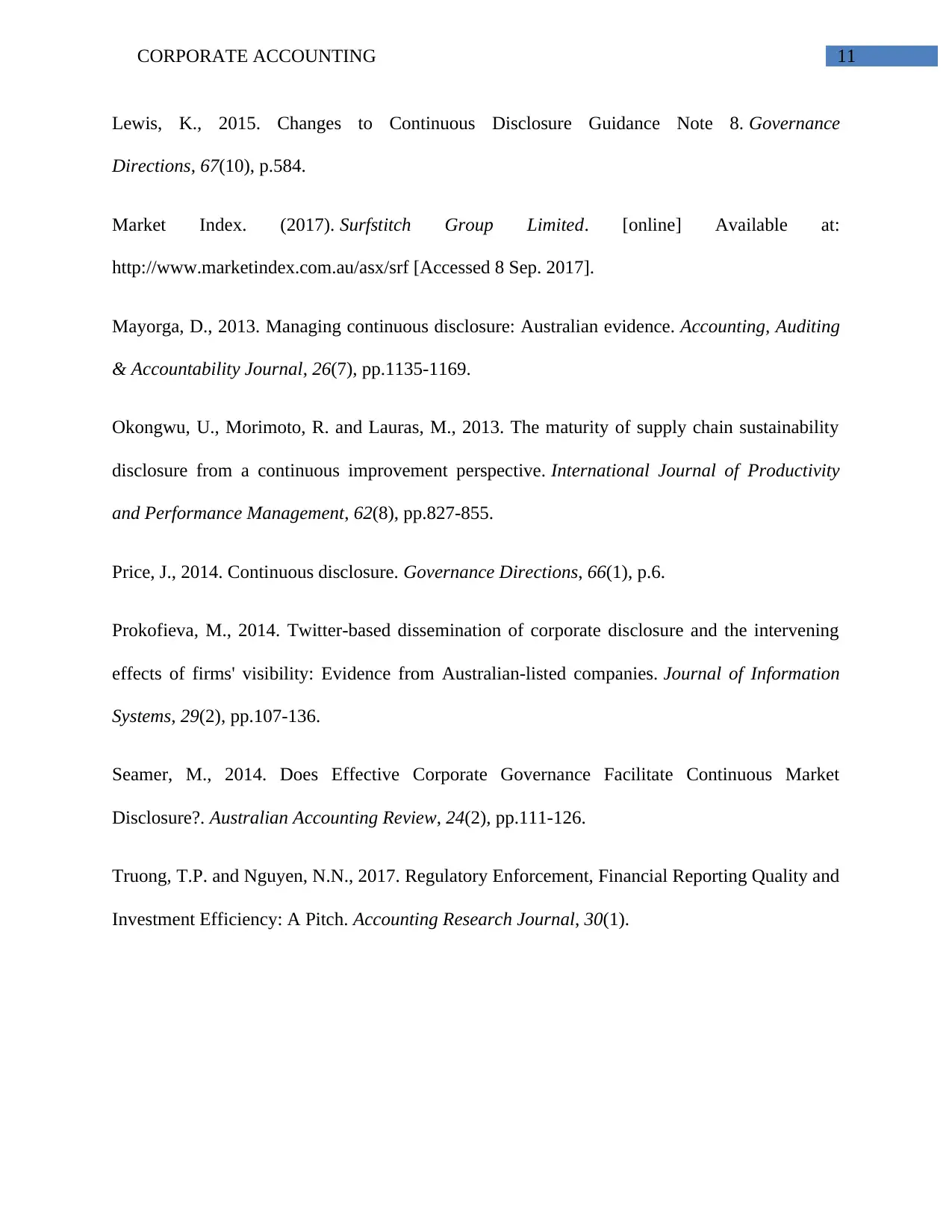
CORPORATE ACCOUNTING 11
Lewis, K., 2015. Changes to Continuous Disclosure Guidance Note 8. Governance
Directions, 67(10), p.584.
Market Index. (2017). Surfstitch Group Limited. [online] Available at:
http://www.marketindex.com.au/asx/srf [Accessed 8 Sep. 2017].
Mayorga, D., 2013. Managing continuous disclosure: Australian evidence. Accounting, Auditing
& Accountability Journal, 26(7), pp.1135-1169.
Okongwu, U., Morimoto, R. and Lauras, M., 2013. The maturity of supply chain sustainability
disclosure from a continuous improvement perspective. International Journal of Productivity
and Performance Management, 62(8), pp.827-855.
Price, J., 2014. Continuous disclosure. Governance Directions, 66(1), p.6.
Prokofieva, M., 2014. Twitter-based dissemination of corporate disclosure and the intervening
effects of firms' visibility: Evidence from Australian-listed companies. Journal of Information
Systems, 29(2), pp.107-136.
Seamer, M., 2014. Does Effective Corporate Governance Facilitate Continuous Market
Disclosure?. Australian Accounting Review, 24(2), pp.111-126.
Truong, T.P. and Nguyen, N.N., 2017. Regulatory Enforcement, Financial Reporting Quality and
Investment Efficiency: A Pitch. Accounting Research Journal, 30(1).
Lewis, K., 2015. Changes to Continuous Disclosure Guidance Note 8. Governance
Directions, 67(10), p.584.
Market Index. (2017). Surfstitch Group Limited. [online] Available at:
http://www.marketindex.com.au/asx/srf [Accessed 8 Sep. 2017].
Mayorga, D., 2013. Managing continuous disclosure: Australian evidence. Accounting, Auditing
& Accountability Journal, 26(7), pp.1135-1169.
Okongwu, U., Morimoto, R. and Lauras, M., 2013. The maturity of supply chain sustainability
disclosure from a continuous improvement perspective. International Journal of Productivity
and Performance Management, 62(8), pp.827-855.
Price, J., 2014. Continuous disclosure. Governance Directions, 66(1), p.6.
Prokofieva, M., 2014. Twitter-based dissemination of corporate disclosure and the intervening
effects of firms' visibility: Evidence from Australian-listed companies. Journal of Information
Systems, 29(2), pp.107-136.
Seamer, M., 2014. Does Effective Corporate Governance Facilitate Continuous Market
Disclosure?. Australian Accounting Review, 24(2), pp.111-126.
Truong, T.P. and Nguyen, N.N., 2017. Regulatory Enforcement, Financial Reporting Quality and
Investment Efficiency: A Pitch. Accounting Research Journal, 30(1).
⊘ This is a preview!⊘
Do you want full access?
Subscribe today to unlock all pages.

Trusted by 1+ million students worldwide
1 out of 12
Related Documents
Your All-in-One AI-Powered Toolkit for Academic Success.
+13062052269
info@desklib.com
Available 24*7 on WhatsApp / Email
![[object Object]](/_next/static/media/star-bottom.7253800d.svg)
Unlock your academic potential
Copyright © 2020–2025 A2Z Services. All Rights Reserved. Developed and managed by ZUCOL.





